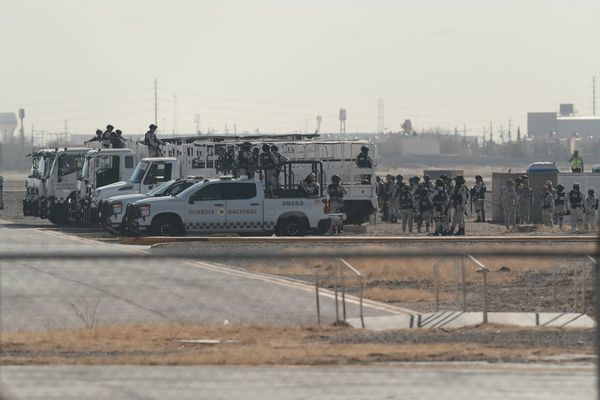
Shocking footage has emerged which shows a wave of mining waste sweeping across everything in its path after a dam collapsed in Brazil leaving 110 people dead.
The newly released video of the dam collapse shows the moment the wave of muddy sludge swamped the mine company’s canteen and neighbouring buildings in Brumadinho.
In one video obtained by The Associated Press, cars can be seen driving around desperately trying to escape as a gush of mud approaches with dramatic strength.
One week after the deadly collapse of the mining dam in the state of Minas Gerais on January 25, dozens paid homage to the 110 victims killed and the 238 who are still missing.
A ceremony was held at the site of the disaster around 1pm local time, the hour at which the dam breached and unleashed a destructive torrent of reddish-brown mining waste.
Backhoes stopped digging in the mud, and rescuers looking for survivors in the thick mine tailings all looked to the sky as 10 helicopters released flower petals on the iron ore mining complex.

A priest also gave a brief mass in front of a tall pink cross that had been planted in the mud.
"It is totally devastated, it looks like there has been a war," said 23-year-old Edvan Cristi, who lost friends who worked at the mine, which was run and operated by Vale SA.
A spokesman for the Minas Gerais Fire Department said after the ceremony that authorities were not calling off the search for bodies although no one had been found alive since Saturday.
On Friday, operations seemed to enter a new phase as firefighters began excavating the mud with heavy machinery. So far, efforts have been focused on finding bodies closer to the surface.

The mayor of the nearby city of Brumadinho, Avimar de Melo Barcelos, told reporters that his municipality remained deeply disrupted because main roads were still blocked by mud. He said rural residents, who account for about 40 per cent of the municipality, could not reach the city centre.
Aside from the human tragedy, Mr de Melo Barcelos stressed that the city would need financial help as nearly 35 per cent of taxes collected for the municipality come from mining activities.
"We are a mining town. If we lose that 35 per cent of tax collection, we're not going to be able to attend to basic social services," the mayor said, citing costs related to health and education.
The tailings, which contain toxic levels of iron oxide, plastered 252 hectares (623 acres) of Brumadinho and the Paraopeba River.

Vale SA said the residues did not have dangerous levels of metals, but experts argue that the impact on the environment could be irreversible.
Authorities and environmental organizations have begun testing water quality around the mining complex, while state and federal authorities have told residents to refrain from using water directly from the Paraopeba or 100-meters (109 yards) around it.
The Paraopeba River flows into the much larger Sao Francisco River, which could also be contaminated.

Hundreds of municipalities and larger cities such as Petrolina, 1,400 kilometres (870 miles) from Brumadinho, get drinking water from the Sao Francisco River.
The wave of mud is currently moving toward the Sao Francisco at about 1 kph (.62 mph), but officials hope the Retiro Baixo hydroelectric dam and plant complex about 300 kilometres (185 miles) from Brumadinho will prevent the mud from contaminating it.
The tailing is expected to reach the Retiro Baixo dam between February 5 and February 10.
A peaceful walk in homage to the victims is expected to take place later Friday in the city centre of Brumadinho.







